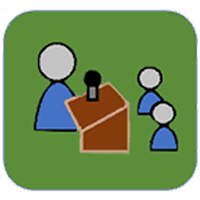Wildland Urban Interface
Fire Aware. Fire Prepared. Wildfire Wednesday’s webinar series hosted by Oregon State University Extension recordings are available on the Fire Program website.
Webinar recording.
Fire Aware. Fire Prepared. Wildfire Wednesday’s with Oregon State University Extension are returning this fall. Visit the Online Webinar Guide on the Fire Program website for more information.
Webinar recording.
During this peer learning session, speakers will:
- Build understanding about the spectrum of complementary actions, based on available science, to protect the built environment and community values from wildfire, improve the ecological resilience of our landscapes, and improve the safety and effectiveness of wildfire management;
- Discuss the concepts of landscape resilience, the wildland urban interface and the home ignition zone, fire management options, and the roles they play in reducing fire risk;
- Address why fire needs to be restored to the landscape;
- Consider the values that could be lost and how they relate to fire; and
- Discuss how to increase the options for fire managers to implement integrated active management.
Webinar recordings.
Monday, December 6: Forest and Rangeland Livelihoods
Leveraging demand for renewable energy and innovative bioproducts to facilitate forest restoration, presented by Nate Anderson
What happened to wood products markets in 2020 and 2021 in the United States?, presented by Jeff Prestemon
Managing wolves and livestock on national forests in the West, presented by Susan Charnley
Tuesday, December 7: Protecting Ecosystem Services
Human ecology mapping: Capturing diverse forest benefits and landscape interactions for use in planning and decision-making, presented by Lee Cerveny
What’s a canopy worth? Using i-Tree to understand the value of trees, presented by Alexis Ellis
Agroforestry: Tools for working across the landscape, presented by Gary Bentrup, Kate MacFarland, Matthew Smith, Richard Straight
Wednesday, December 8: Bounty Beneath Our Feet
Why is biochar so important?, presented by Debbie Page-Dumroese
Establishing pollinator habitat in log landings after timber sales begins with restoring the soil, presented by John Kabrick
Soil organic carbon, presented by Andy Coulter and Stephanie Connolly
Thursday, December 9: Urban Interfaces
A shared stewardship approach to wildland fire mitigation in Eastern Oklahoma, presented by Cassandra Johnson Gaither
Urban forestry, presented by Natalie van Doorn
Fire WUI urban communities, presented by Francisco Escobedo
Friday, December 10: Getting Outside
Managing winter recreation and sensitive species on Colorado’s public lands: Do humans and Canada lynx select the same habitat?, presented by Lucretia Olson
Considering the benefits of recreation in program reporting and decision-making, presented by Eric White
Latinix outdoor recreation, presented by Jose Sanchez
Conference website for on-demand content.
The International Assoc of Fire Chief’s Wildland-Urban Interface (WUI) conference offers hands-on training and interactive sessions designed to address the challenges of wildland fire. If you’re one of the many people responsible for protecting local forests or educating landowners and your community about the importance of land management—then this is the conference for you.
Conference was held at the Peppermill Resort in Reno, NV.
View article.
Our results show that 57% of structures (homes, schools, hospitals, office buildings, etc.) are located in hazard hotspots, which represent only a third of CONUS area, and ∼1.5 million buildings lie in hotspots for two or more hazards. These critical levels of exposure are the legacy of decades of sustained growth and point to our inability, lack of knowledge, or unwillingness to limit development in hazardous zones. Development in these areas is still growing more rapidly than the baseline rates for the nation, portending larger future losses even if the effects of climate change are not considered.
Webinar recording.
Description: As communities across the U.S. face increasing threats from wildfire, there is also a growing interest in land use planning as a strategy to reduce risk and foster more resilient outcomes. Land use planning provides a variety of tools, such as growth management plans, subdivision regulations, or wildland-urban interface (WUI) codes that can be applied in wildfire-prone areas. These tools can support public safety and emergency response, direct growth away from high hazard areas, and can complement other fire adapted activities such as vegetation management. However, selecting the appropriate tools and integrating them with other approaches often takes consideration of many factors—such as existing state requirements, potential shifts in demographic and development patterns, political will, and enforcement capacity. This webinar will provide a brief history of planning in the WUI for context, and highlight different planning tools and implementation strategies available to state and local governments—including examples from across the West.
Presenter: Molly Mowery, AICP, Executive Director, Community Wildfire Planning Center
Visit event recordings.
The NM Wildland Urban Summit is attended by community members, fire service volunteers and professionals, non-profit conservation groups engaged in fire adaptation, and federal, state and local government representatives.
View article.
The Fireshed Registry is a geospatial dashboard and decision tool built to organize information about wildfire transmission to communities and monitor progress towards risk reduction for communities from management investments. The concept behind the Fireshed Registry is to identify and map the source of risk rather than what is at risk across all lands in the continental United States. While the Fireshed Registry was organized around mapping the source of fire risk to communities, the framework does not preclude the assessment of other resource management priorities and trends such as water, fish and aquatic or wildlife habitat, or recreation. The Fireshed Registry is also a multi-scale decision tool for quantifying, prioritizing, and geospatially displaying wildfire transmission to buildings in adjacent or nearby communities.
The fire spread rate within WUI communities is determined for nine wildfires that were ranked among the most destructive wildfires in North America. An improved quasi-empirical model that considers radiation and fire spotting as modes of fire spread inside a community is proposed. The new model is validated using the documented spread rates during the 2007 Witch and Guejito fires and the 2017 Tubbs fire. The proposed model is computationally efficient and can be used to quantify fire spread rate and the number of affected structures inside a community during a wildfire event.




